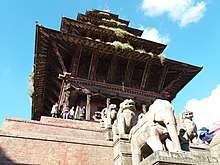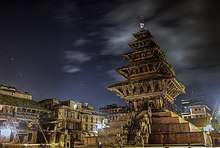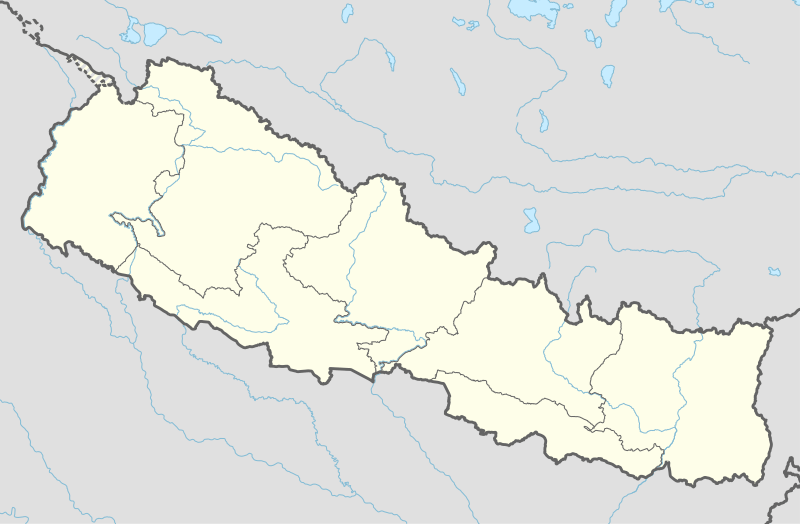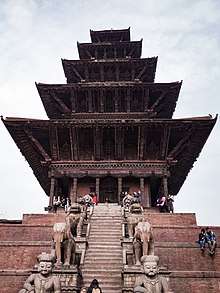Nyatapola Temple
Nyatapola Temple is a 5-storeyed (Nyata "ङाता" = 5 Storeys "तल्ला & Pola "पोलँ" = Roof "छाना") Hindu temple. Meaning is Five Storeys Roofed Temple. Pagoda Style temple located in Bhaktapur, Nepal. The temple was erected by Nepali King Bhupatindra Malla during a 7-month period from late 1702 to 1703. It is the temple of Siddhi Lakshmi, the Tantric Lakshmi who bestows auspiciousness.[1]

| Nyatahpolhhj (Nyatapola "ङातापोलँ") | |
|---|---|
 Nyatapola | |
| Religion | |
| Affiliation | Hinduism |
| District | Bhaktapur |
| Deity | Siddhi Lakshmi, Durga |
| Festivals | Dashain |
| Location | |
| Location | Bhaktapur, Taumadhi/Tahmhari ("तःम्हारी", तः=ठूलो + म्हारी=रोटी, means Large Bread) |
| Country | Nepal |
 location in nepal | |
| Geographic coordinates | 27°40′17″N 85°25′43″E |
| Architecture | |
| Type | Pagoda |
Construction
Bhaktapur is one of the three cities found in the Kathmandu Valley in Nepal not far from the capital city of Kathmandu. The name Bhaktapur means "City of Devotees". Today this ancient, medieval city, from the fifteenth century, is part of the UNESCO World Heritage site, which records buildings that are of cultural and natural value universally.
How it was built
It was built in only 17 months from the time it started. From King Bhupatindra Malla`s account book states the structure was built in only 7 months by the help of other neighboring communities like Challing, Jitpur, Bagshowari, Shakhu, Jhaukhel, Changu, Gokarna, and Paunati to name a few. His kingdom had a rivalry with western neighbors Kritipur and Kantipur, and so to show his power, he built the impressive building. It was built in a time when the Taj Mahal was under construction. He also stated that he had built 7 brick factory for bricks and all raw materials were brought in advance. The biggest challenge was to bring a huge stone from Challing which is almost 9 km from the temple. At last, he called for the feast to all citizen and neighbors kings to show. In that feast, about 23,000 people were there; four times than the population of Bhaktapur. It was written in a book which was discovered by Dr. Janak Lal Vaidya.
The Nyatapola Temple
One of the temples that are still in existence today is the Nyatapola Temple, which was built in 1702 A.D. under the rule of King Bhupatindra Malla. This beautifully sculptured building is considered one of the tallest pagodas in the country and is a lovely example of the immense workmanship that went into buildings of this type. This five-storey temple with a five-tier roof that stands just over thirty meters high can be reached by walking up a flight of steps that leads to the top of the platform. As you walk up these terraces you will notice that there are statues on either side of you, on every step.

Religious figures and gods
The Nyatapola temple was built and dedicated to the goddess Siddhi Lakshmi or Siddhi Laxmi, providing the Nepalese with a place to worship her. Like so many of the other temples, the image of the goddess that is contained within the temple of Nyatapola is maintained strictly by the priests only. Dominating Taumadhi Square is the Nyatapola Temple, a five-tiered pagoda dedicated to the Hindu goddess Siddhi Lakshmi. The temple rests on a base of five levels with four Ganesh shrines in each of the corners. Nyatapola means "five-story temple" in the Newari language.
The Legend
Legend tells of the days when the Lord Bhairava, the Hindu God of destruction was causing havoc in society (1078 AD). Bhairava’s temple stood in Taumadhi Square. To counteract his destructive behavior the king decided to call goddess parvati, then Parvati took the form of Siddhi Laxmi and then carried Bhairava in her hand and built a more powerful temple on the honor of Siddhi Laxmi (Parvati) right in front of the Bhairab Temple. To make the brick and wood temple strong and powerful, King Bhupatendra Malla ordered guardians be placed in pairs on each level of the base leading up to the Nyatapola Temple. On the first level is a pair of likenesses of Bhaktapur’s strongest man, Jaya mal Pata, a famous wrestler. Next, two elephants followed by two lions, two griffons and finally "Baghini" and "Singhini", the tiger and lion goddesses. After subduing Bhairaba, peace prevailed in the city. The Temple is the tallest temple in the Kathmandu Valley and stands 30 m high. It was so well designed that it withstood the 1934 Nepal–Bihar earthquake.
The image of Siddhi Lakshmi is locked within the temple and only the priests are allowed to enter to worship her. The five-storeyed temple, locally known as Nyatapola, is an impressive and famous temple of Nepal, standing in the northern side of Taumadhi Square in Bhaktapur. This is the only temple that is named after the dimension of architecture rather than from the name of the deity residing inside. The temple was erected within a short period of fewer than five months by King Bhupatindra Malla in 1701/1702 A.D. In the present context of work-schedule, planning, and programming, it is very difficult to believe that the temple was erected within that short period of time. But it was the fact. The incidents are recorded day by day.
If we look at the calendar of construction it gives us an interesting picture of the spirit of the people and speed of the work accomplished within such a short period of time. The speed of work done in religious faith can never be accomplished in a modern-day society run by materialistic considerations.
2015 earthquake
The Bhairav kale survived the 2015 earthquake in spite of having the tallest shikhara in the valley. Many other temples were also damaged in the 2016 earthquake.[2][3] It had also survived the 1934 Nepal–Bihar earthquake that had damaged many other temples.[4]
Historical Sources and records

These interesting details were found while going into the Siddhagni Kotyahuti Devala Pratistha manuscript.[5] From the start of digging the foundation to the completion of roofing, it took merely eighty-eight days. The excavation work for foundation lasted for seven days. Then was commenced construction of six plinths. That was accomplished in thirty-one days, and immediately after that started the erection of the superstructure. That was also completed within thirty-four days, after which roofing work was started from top to the lowest roof. In sixteen days all the five roofs were completed paving them with mini-tiles (Jhingati). Then they had to wait for an auspicious day for erecting the icons in the sanctum sanctorum and fix the pinnacle on the top of the temple. For this, they did wait for 38 days. In the meantime, the auspicious fire-sacrifice (Siddhagni Kotyahuti Yajna) was going on.
Presented here are six pages (three folios) of the facsimile copies of the manuscript which recorded major events from beginning to the end, as a summary of records in advance, incorporated in the manuscript containing 264 folios. There are fifty major records in the summary six-page facsimile.
The manuscript is preserved in the National Archives of Nepal. It is readily available for the readers in microfilm as well, which can be read in the office or could be purchased in photocopy paying certain rupees per page.
The name of the manuscript is recorded as Siddhagni Kotyahuti Devala Pratistha. The name itself kept the enthusiasts on the subject of ancient architecture behind the curtain from knowing it. The accession number of the manuscript is ca. I. 1115 NGMPP micro number A 249/5. The manuscript is written in the Newar script in yellow Nepalese paper coated with Harital (orpiment). The size is 17.2 x 46.5 cm. Each page has nine lines. The manuscript has 264 folios, and the rest are missing Dr. Janak Lal Vaidya thinks. Some folios are ink-stained and some are damaged by rats. All the rest of the folios are in good condition. The calligraphy is magnificent.
Out of these six facsimile pages, Dr. Janak Lal Vaidya has published three folios (1, 2 and 4) without any transliteration and translation in Abhilekh No.8 published by the National Archives of Nepal. It is, however, necessary at least to give a full picture of the detailed records in those six important pages.
There is still interesting information contained in the following folios of the manuscript which were published by Dr. Janak Lal Vaidya in his articles published in Abhilekh, No. 8 and No. 14 and Kheluita No. 11 in English, Nepali and Newar respectively.
Gallery
 Festival
Festival- Wooden construction details
- Wooden construction
 Nyatpola & Bhairav Temples
Nyatpola & Bhairav Temples.jpg) Bhairav Temple from Nyatpola
Bhairav Temple from Nyatpola.jpg) Taumadhi Square
Taumadhi Square- Wooden wheels of a disassembled festival cart for Bisket Jatra
- Bhojanalaya overlooking the temples






 Wide view of Nyatapola Temple
Wide view of Nyatapola Temple Another Side of Nyatapola Temple
Another Side of Nyatapola Temple
References
- "Work index of Nyatapola temple". Goliath Business News. Retrieved 9 September 2009.
- Just returned from Bhaktapur, Nepal: Lesson learned the hardest way, ETN NEPAL, APR 29, 2015
- Man, baby rescued from rubble in Nepal, CNN, Apr 29, 2015, Chief Medical Correspondent Dr. Sanjay Gupta reports from Nepal, at 1:48
- Nepal earthquake: Centuries of architectural heritage gone in 80 seconds, PTI, Mid-Day, 01-May-2015
- Research Note Work Index Of Nyatapola Temple, Contributions to Nepalese Studies, Vol. 32, NO.2 (July 2005), 267–275.